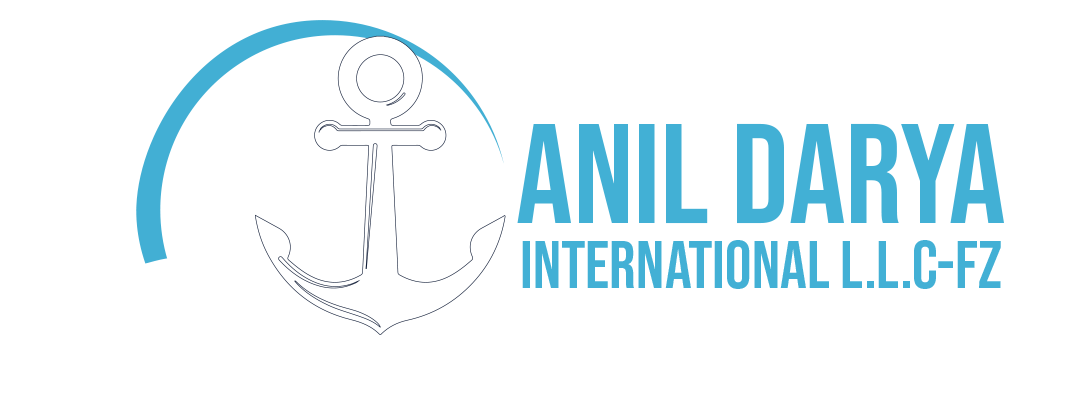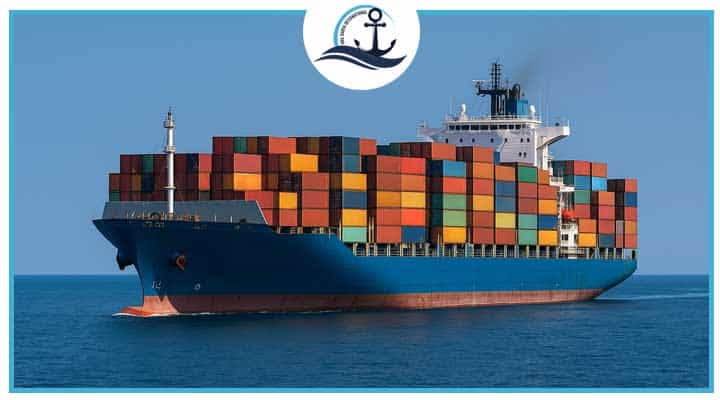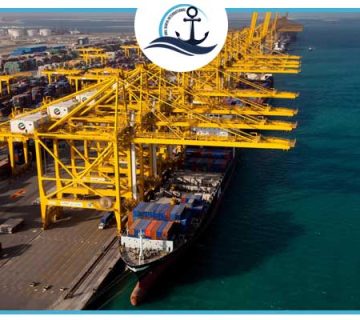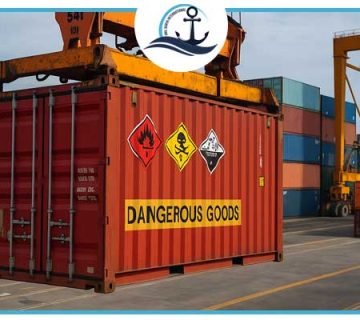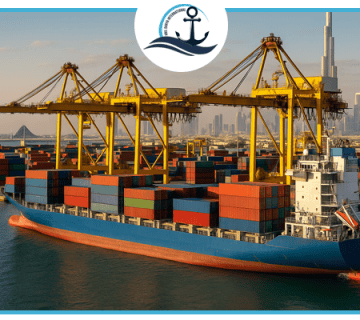|
Getting your Trinity Audio player ready...
|
Sea Freight Challenges in the Gulf: Weather, Congestion & Rules
The Arabian Gulf remains one of the world’s most dynamic maritime gateways — linking the East to the West through vital trade lanes that run through Dubai, Jebel Ali, and the Strait of Hormuz. Yet, beneath this strategic advantage lies a network of operational, climatic, and regulatory challenges that continually test the resilience of carriers and freight forwarders.
For companies like Anil Darya Shipping, which handle everything from general cargo to dangerous goods (DG), break-bulk, and multimodal freight, mastering these Gulf-specific hurdles has become both an art and a science.
1- The Unforgiving Climate of the Gulf
The first and perhaps most relentless challenge in Dubai Gulf sea freight is the region’s climate.
Extreme heat, high humidity, and sandstorms all combine to create operational difficulties for vessels and port terminals alike.
During the peak summer months, ambient temperatures exceed 45°C, which can affect not only machinery and cooling systems but also crew endurance and cargo integrity — especially for perishable or chemical goods.
Sudden dust storms, common across the UAE and Saudi coastline, drastically reduce visibility and delay loading operations at Jebel Ali Port.
In winter, dense fog frequently halts marine traffic in the approaches to Dubai, Abu Dhabi, and Fujairah, causing port congestion and cascading schedule delays.
Each one-hour delay in docking or clearance can lead to ripple effects across the entire regional supply chain.
To mitigate this, Anil Darya Shipping employs advanced voyage-planning systems and weather analytics, enabling dynamic re-routing to minimize downtime.
Predictive AI tools, similar to those used in aviation logistics, now help estimate sea conditions hours in advance — a practice that has become crucial for Gulf maritime logistics where timing determines profitability.
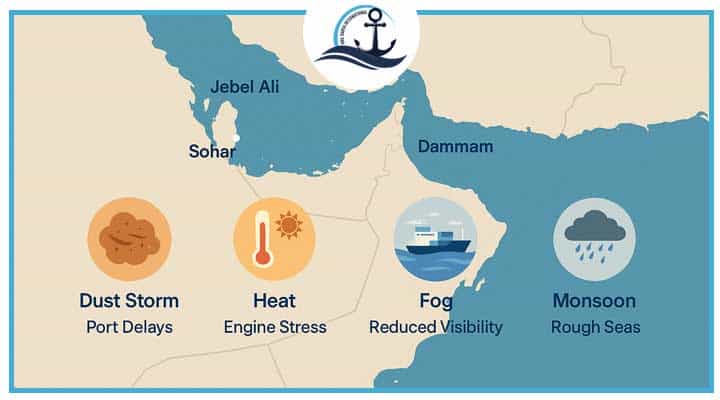
2- Seasonal Trade Patterns and Cargo Imbalance
Another under-discussed challenge in Gulf shipping is cargo imbalance between inbound and outbound flows.
Dubai, as a re-export hub, handles large import volumes for consumer goods and raw materials from Asia — but the return leg often lacks equivalent outbound cargo.
This imbalance forces carriers to reposition empty containers, adding hidden costs to the shipping challenges UAE companies face.
During Ramadan and Eid seasons, import surges can overload ports and inland transport systems, while the post-holiday slowdown leaves terminals underutilized.
Similarly, agricultural export peaks from Gulf Cooperation Council (GCC) countries to North Africa and India often clash with monsoon disruptions, amplifying delays and demurrage costs.
Anil Darya Shipping leverages flexible vessel scheduling and consolidation services to counter these patterns. Through groupage and shared-container solutions, they balance supply chains, ensuring cost-effective movement even when market demand fluctuates seasonally.
Seasonal
Demand Shifts
Modal
Preferences
Economic
Changes
Harsh
Wheather
3- Port Congestion and Infrastructure Limitations
Despite Dubai’s world-class infrastructure, congestion remains a recurring pain point.
Jebel Ali Port alone handles millions of TEUs annually, ranking among the top ten busiest container ports globally.
While its automated cranes and smart gates have improved throughput, high transshipment volumes during peak quarters create bottlenecks.
For break-bulk or project cargo, the problem intensifies — since oversized loads require specialized cranes, extended handling time, and safety inspections.
This can block berths longer than container vessels, slowing port rotation for other carriers.
A growing solution has been multimodal freight integration — using Dubai’s road and air corridors to bypass sea congestion.
For example, combining sea–air freight via Dubai’s logistics zones (JAFZA–DXB corridor) cuts transit time by up to 50%.
Anil Darya Shipping routinely adopts such hybrid models to maintain consistent delivery schedules for time-critical cargo, whether DG shipments to Africa or industrial equipment bound for Europe.
Peakol Volume
Arrival
Peak Season Volume
Waiting Berth
Limited Crane Availibility
Unloading
Documentation Hold
Customs
Gate Exit
4- Navigating a Maze of Regulations
Maritime regulation across the Gulf is a complex patchwork of national laws, port authority rules, and IMO conventions.
While the UAE leads the region in digital customs processing, each neighboring port — from Dammam to Sohar — maintains unique documentation requirements.
This diversity challenges even seasoned freight forwarders when handling cross-Gulf shipments.
Recent updates like IMO Amendment 42-24 (covering the IMDG Code revisions for DG cargo) and the Dubai Code of Practice for Dangerous Goods have introduced stricter obligations on classification, segregation, and declaration.
Carriers must now submit DG manifests electronically prior to vessel arrival, with detailed HS codes and UN numbers verified at origin.
Non-compliance, even due to clerical errors, can result in fines or cargo detainment — translating into days of delay.
Anil Darya Shipping’s compliance team continuously monitors these changes, offering pre-shipment DG verification, packaging audits, and consultation with Dubai Customs to ensure seamless processing.
This proactive stance keeps shippers compliant while maintaining the highest standards of cargo safety and transparency.
5- Maritime Security and Political Tensions
The Gulf’s strategic geography is both its strength and its vulnerability.
The Strait of Hormuz, through which around 20% of global oil trade passes, is a sensitive chokepoint often affected by regional security fluctuations.
Any escalation — from naval exercises to diplomatic stand-offs — can disrupt sailing schedules and raise war-risk premiums.
Such volatility makes risk management a central pillar of Gulf maritime logistics.
Forwarders must prepare contingency routes, alternate ports (such as Fujairah), and ensure insurance compliance for high-value shipments.
Anil Darya Shipping maintains partnerships with marine underwriters and local port authorities, ensuring clients’ cargoes continue their journey safely — even when others pause operations.
Their localized presence in Dubai gives them an operational advantage during high-alert periods when international carriers often hesitate.
Net-Zero Maritime Emissions
Wind & Electric Propulsion Pilots
LNG and Hybrid Fuel Mix
Engine Efficiency & Route Optimization
Low-Sulfur Fuel Adoption
6- Technology and IoT: Transforming Maritime Logistics
Modern shipping no longer relies solely on manpower — it runs on data.
IoT devices now track container temperature, shock exposure, and location in real time.
Dubai’s ports have adopted blockchain-based documentation and smart berthing systems, reducing clearance times significantly.
Yet, interoperability remains a challenge. Not all Gulf ports have fully embraced these technologies, leading to partial digital gaps in the supply chain.
For example, a shipment that departs Jebel Ali under blockchain may face manual verification at another Gulf terminal, nullifying the benefit of automation.
This is where forwarders like Anil Darya Shipping bridge the gap.
By using integrated freight management platforms, they synchronize sea, air, and land operations under one digital ecosystem.
Their system links directly with customs portals, enabling clients to track cargo in real time — an approach closely aligned with innovations discussed in “How Technology & IoT Are Transforming Freight Tracking in Dubai Logistics.”
This synergy between technology and traditional shipping expertise defines Dubai’s evolution into a truly smart logistics hub.
Integrated Freight Solutions
Sea, Air & Land coordination for total visibility
Regulatory Compliance Expertise
IMO, UAE DG Code, and port Regulations
Global Multimodal Network
Seamless foutes through Guff, Asia & Europe
Sustainable
Operations
Green shipping, optimized routes, and eco fuals
7- Sustainability and the Green Transition
Another major challenge facing Dubai Gulf sea freight operators is sustainability compliance.
The International Maritime Organization (IMO) targets for carbon intensity reduction (CII) and energy efficiency (EEXI) are reshaping how vessels operate.
The UAE, as a signatory to the Paris Agreement, has introduced its own green shipping roadmap encouraging low-sulfur fuels, alternative propulsion systems, and carbon-offset mechanisms.
Transitioning to such eco-friendly practices, however, is costly. Smaller carriers struggle to retrofit engines or procure green bunker fuel, while larger operators pass these costs downstream.
Clients must now balance price, sustainability, and delivery time — a triad that defines the modern shipping equation.
Anil Darya Shipping embraces this shift by implementing eco-route planning, optimizing engine performance, and supporting cargo consolidation that minimizes empty miles.
These practices align with Dubai’s “green maritime strategy” and directly reduce CO₂ emissions .
8- Human Capital and Workforce Adaptation
Behind every vessel movement lies a workforce adapting to technological and regulatory evolution.
Crew shortages, new digital skills requirements, and safety training under revised IMO codes present operational challenges.
In the Gulf, extreme climate adds another layer — crew welfare during long port stays in 45°C temperatures demands careful management.
Dubai’s maritime academies and corporate training initiatives are helping build the next generation of seafarers and logistics professionals.
Anil Darya Shipping contributes by providing specialized DG handling workshops, safety drills, and real-time cargo management training to its teams and partners.
9- Regional Collaboration: The Future of Gulf Maritime Logistics
The road ahead for Gulf maritime logistics depends on stronger regional collaboration.
The GCC states are exploring harmonized customs frameworks and joint port-digitization projects to eliminate redundant inspections.
Once operational, these systems will streamline intra-Gulf shipping and reduce average transit times by up to 20%.
Dubai’s leadership through JAFZA, DP World, and strategic corridors to Oman and Saudi Arabia will continue positioning the UAE as the Gulf’s logistics capital.
But true progress will require integration — not just infrastructure.
Anil Darya Shipping, with its multi-modal and cross-border expertise, stands at the forefront of this transition, connecting Gulf markets under one operational network.
Why Choose Anil Darya Shipping?
In a region where weather, congestion, and regulation constantly change, reliability becomes a competitive advantage.
Anil Darya International L.L.C-FZ offers more than freight forwarding — it provides assurance, compliance, and innovation under one brand.
Whether you’re shipping DG cargo from Dubai to Africa, a break-bulk project to Europe, or re-exports through the Gulf’s free zones, Anil Darya’s expertise ensures:
- Predictable transit times despite congestion or climate issues
- Full IMDG and UAE customs compliance
- Integrated visibility across sea, air, and land modes
- Commitment to sustainability and transparent pricing
Your cargo deserves a partner that anticipates challenges — not just reacts to them.
Frequently Asked Questions (FAQ)
Because it combines environmental extremes, regulatory diversity, and geopolitical sensitivity — all within a high-traffic maritime zone. Only experienced operators can consistently navigate these variables.
The company conducts pre-shipment DG classification, documentation checks, and on-site labeling inspections based on Dubai’s Dangerous Goods Code of Practice and IMO 42-24 amendments.
IoT tracking, AI route optimization, blockchain documentation, and automated port gates. These tools boost visibility and reduce dwell time — especially around Dubai’s ports.
Dust storms, fog, and summer heat lead to port slowdowns and maintenance delays, while terminal congestion extends berth waiting times. Reliable forwarders mitigate this through proactive planning and multi-modal alternatives.
Yes. The UAE’s maritime strategy encourages carriers to adopt low-emission practices, green bunkering, and digital tracking to align with IMO’s 2030 and 2050 goals.
